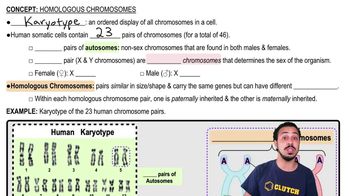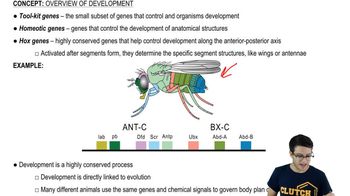Use your understanding of insect evolution to predict two adaptations for terrestrial living that occurred in spiders.
Table of contents
- 1. Introduction to Biology2h 42m
- 2. Chemistry3h 40m
- 3. Water1h 26m
- 4. Biomolecules2h 23m
- 5. Cell Components2h 26m
- 6. The Membrane2h 31m
- 7. Energy and Metabolism2h 0m
- 8. Respiration2h 40m
- 9. Photosynthesis2h 49m
- 10. Cell Signaling59m
- 11. Cell Division2h 47m
- 12. Meiosis2h 0m
- 13. Mendelian Genetics4h 44m
- Introduction to Mendel's Experiments7m
- Genotype vs. Phenotype17m
- Punnett Squares13m
- Mendel's Experiments26m
- Mendel's Laws18m
- Monohybrid Crosses19m
- Test Crosses14m
- Dihybrid Crosses20m
- Punnett Square Probability26m
- Incomplete Dominance vs. Codominance20m
- Epistasis7m
- Non-Mendelian Genetics12m
- Pedigrees6m
- Autosomal Inheritance21m
- Sex-Linked Inheritance43m
- X-Inactivation9m
- 14. DNA Synthesis2h 27m
- 15. Gene Expression3h 20m
- 16. Regulation of Expression3h 31m
- Introduction to Regulation of Gene Expression13m
- Prokaryotic Gene Regulation via Operons27m
- The Lac Operon21m
- Glucose's Impact on Lac Operon25m
- The Trp Operon20m
- Review of the Lac Operon & Trp Operon11m
- Introduction to Eukaryotic Gene Regulation9m
- Eukaryotic Chromatin Modifications16m
- Eukaryotic Transcriptional Control22m
- Eukaryotic Post-Transcriptional Regulation28m
- Eukaryotic Post-Translational Regulation13m
- 17. Viruses37m
- 18. Biotechnology2h 58m
- 19. Genomics17m
- 20. Development1h 5m
- 21. Evolution3h 1m
- 22. Evolution of Populations3h 53m
- 23. Speciation1h 37m
- 24. History of Life on Earth2h 6m
- 25. Phylogeny2h 31m
- 26. Prokaryotes4h 59m
- 27. Protists1h 12m
- 28. Plants1h 22m
- 29. Fungi36m
- 30. Overview of Animals34m
- 31. Invertebrates1h 2m
- 32. Vertebrates50m
- 33. Plant Anatomy1h 3m
- 34. Vascular Plant Transport1h 2m
- 35. Soil37m
- 36. Plant Reproduction47m
- 37. Plant Sensation and Response1h 9m
- 38. Animal Form and Function1h 19m
- 39. Digestive System1h 10m
- 40. Circulatory System1h 49m
- 41. Immune System1h 12m
- 42. Osmoregulation and Excretion50m
- 43. Endocrine System1h 4m
- 44. Animal Reproduction1h 2m
- 45. Nervous System1h 55m
- 46. Sensory Systems46m
- 47. Muscle Systems23m
- 48. Ecology3h 11m
- Introduction to Ecology20m
- Biogeography14m
- Earth's Climate Patterns50m
- Introduction to Terrestrial Biomes10m
- Terrestrial Biomes: Near Equator13m
- Terrestrial Biomes: Temperate Regions10m
- Terrestrial Biomes: Northern Regions15m
- Introduction to Aquatic Biomes27m
- Freshwater Aquatic Biomes14m
- Marine Aquatic Biomes13m
- 49. Animal Behavior28m
- 50. Population Ecology3h 41m
- Introduction to Population Ecology28m
- Population Sampling Methods23m
- Life History12m
- Population Demography17m
- Factors Limiting Population Growth14m
- Introduction to Population Growth Models22m
- Linear Population Growth6m
- Exponential Population Growth29m
- Logistic Population Growth32m
- r/K Selection10m
- The Human Population22m
- 51. Community Ecology2h 46m
- Introduction to Community Ecology2m
- Introduction to Community Interactions9m
- Community Interactions: Competition (-/-)38m
- Community Interactions: Exploitation (+/-)23m
- Community Interactions: Mutualism (+/+) & Commensalism (+/0)9m
- Community Structure35m
- Community Dynamics26m
- Geographic Impact on Communities21m
- 52. Ecosystems2h 36m
- 53. Conservation Biology24m
31. Invertebrates
Ecdysozoans
Problem 9
Textbook Question
Suppose that a gene originally identified in nematodes (roundworms) is found to be homologous with a gene that can cause developmental abnormalities in humans. Would it be possible to use fruit flies as a model organism to study this gene? Explain.
 Verified step by step guidance
Verified step by step guidance1
Understand the concept of homologous genes: Homologous genes are genes that share a common ancestry and often have similar sequences and functions across different species. This means that studying a homologous gene in one organism can provide insights into its function in another organism.
Recognize the importance of model organisms: Fruit flies (Drosophila melanogaster) are widely used as model organisms in biological research due to their genetic similarity to humans, short life cycle, ease of genetic manipulation, and well-characterized genome.
Consider the evolutionary conservation of genes: If the gene in question is homologous between nematodes and humans, it is likely conserved across other species, including fruit flies. This conservation suggests that fruit flies may possess a similar version of the gene, making them suitable for study.
Evaluate the experimental advantages of fruit flies: Fruit flies allow researchers to perform genetic experiments, such as gene knockouts, overexpression studies, and mutational analyses, to investigate the gene's role in development and its potential link to abnormalities.
Conclude the feasibility of using fruit flies: Based on the evolutionary conservation of homologous genes and the experimental tools available for fruit flies, it would be possible and scientifically valuable to use fruit flies as a model organism to study the gene and its effects on development.
 Verified video answer for a similar problem:
Verified video answer for a similar problem:This video solution was recommended by our tutors as helpful for the problem above
Video duration:
2mPlay a video:
Was this helpful?
Key Concepts
Here are the essential concepts you must grasp in order to answer the question correctly.
Homologous Genes
Homologous genes are genes that share a common ancestry, meaning they have evolved from a common ancestral gene. This similarity can be observed in their DNA sequences and functions across different species. Studying homologous genes allows researchers to understand evolutionary relationships and the conservation of biological functions, which is crucial when investigating gene functions in model organisms.
Recommended video:
Guided course

Homologous Chromosomes
Model Organisms
Model organisms are non-human species that are extensively studied to understand biological processes, genetics, and disease mechanisms. Common examples include fruit flies (Drosophila melanogaster), mice, and zebrafish. These organisms are chosen for their genetic tractability, short life cycles, and the ability to produce large numbers of offspring, making them ideal for experimental research and insights applicable to other species, including humans.
Recommended video:
Guided course

Introduction to Population Growth Models
Developmental Biology
Developmental biology is the study of the processes by which organisms grow and develop, focusing on the genetic, cellular, and molecular mechanisms that guide these processes. Understanding developmental biology is essential when investigating genes that cause abnormalities, as it provides insights into how specific genes influence development and how disruptions can lead to malformations or diseases in organisms, including humans.
Recommended video:
Guided course

Hox Genes

 8:01m
8:01mWatch next
Master Arthropods and Chelicerata with a bite sized video explanation from Jason
Start learningRelated Videos
Related Practice
Textbook Question
696
views
